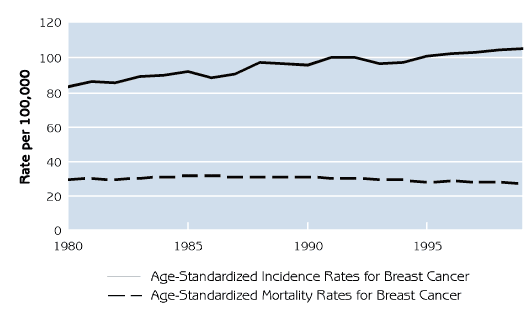Common menu bar links
Institutional links
Diseases & Conditions
Health & Safety
Research & Statistics
Agency Information
Search Box
E-mail this page
Organized Breast Cancer Screening Programs in Canada - 1996 Report
Background
Breast cancer is the most common cancer diagnosed in women in Canada. As a cause of cancer deaths, breast cancer ranks second to lung cancer. An estimated 18,700 new cases of breast cancer and 5,400 deaths from breast cancer will occur in Canada in 1999.1 Age-adjusted incidence rates have increased steadily over the past decade, in part because of the greater use of mammography as a breast cancer screening tool. Mortality rates, however, have declined slightly since 19851 (see Figure 1).
| Figure 1 Age-standardized incidence and mortality rates for breast cancer in Canada, 1980-1999 |
 |
| Source: National Cancer Institute of Canada: Canadian Cancer Statistics 1999, Toronto, Canada, 1999. |
Characteristics associated with a higher risk of breast cancer include a family history of primary breast cancer, higher socioeconomic status, early age at menarche, late age at menopause, low parity, and late age at first full-term pregnancy.2 Few of these risk factors are easily modified, making primary prevention an unpromising option for reducing breast cancer incidence. Secondary prevention by mammographic screening, however, has been proven to reduce breast cancer deaths. The results of randomized trials have shown that screening can reduce the rate of death from breast cancer by up to 40% among women aged 50 to 69.3-5
[Previous] [Table of Contents] [Next]
